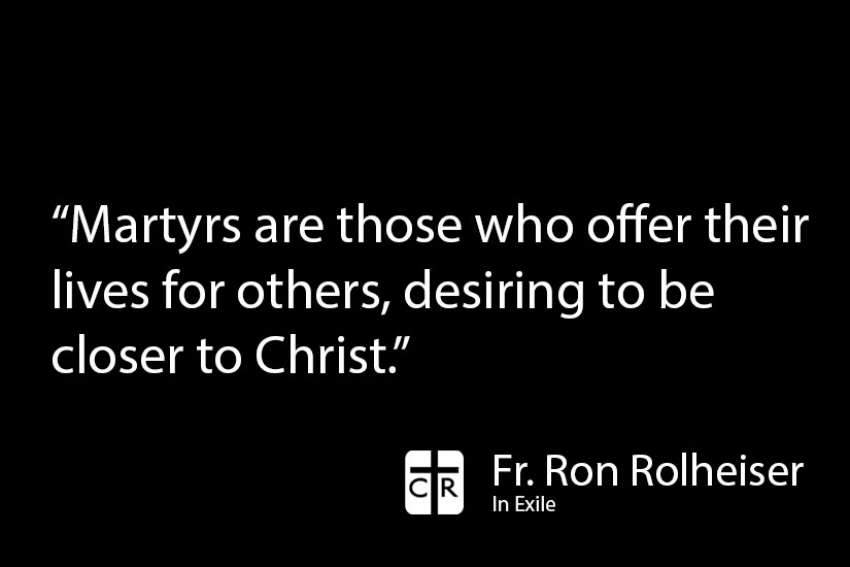The perspective of 19 centuries supports these oft-repeated words of Tertullian, penned in secondcentury Africa.
The martyrs’ witness did much to assist the Church’s rapid growth and expansion in its early days. By publicly, brutally, executing those who steadfastly claimed Christ as God, Roman emperors desired the opposite effect. Ten emperors, over the first three centuries, were particularly aggressive. They wished to destroy Christianity, deeming it subversive because it claimed allegiance to an authority other than the Empire and its Emperor.
Tertullian was right: it didn’t work that way. The martyrs, their courage and grace, did more to advertise Christianity than the Internet does to advertise soft drinks. Nero, in Quo Vadis, after furiously condemning dozens of Christians to be torn apart in the Colosseum, goes afterwards to see their bodies.
Uncovering them one by one, he asserts — first wonderingly, then angrily— “They’re smiling! Why do these Christians smile so?”
In the early Church, saints were simply martyrs. Not until later did Christianity think someone other than those who died violently for refusing to apostasize (“red martyrdom”) might also be reverenced as a saint (“white martyrdom,” white being the Easter colour).
Today, few of us expect to be saints and fewer expect to be martyrs. Yet martyrdom is among us. After 28 Copts on an Egyptian bus were killed because at gunpoint they wouldn’t renounce their faith in Christ, Pope Francis said: “Let’s not forget that today there are more Christian martyrs than in ancient times, than in the early days of the Church.”
He condemned the notion that such killings happen “in the name of God.” The destruction is evident, not only of lives taken, but also of faith itself, made into an instrument of terror. False martyrdom can erode faith in the faith.
Does all this violence call into question the honour the Church has always given to martyrdom?
Jesus died a cruel death without offering in return even the slightest violence. The Church has long depicted Him as a lamb, undefended. In honouring martyrs, we shouldn’t be reverencing violence, which the Lamb of God overcame. Martyrdom is about something else, as the martyrs themselves show.
An influential martyr was St. Ignatius, second bishop of Antioch (Syria) and, tradition says, a student of John the Evangelist. Having long served as bishop, in his old age Ignatius was arrested and taken by ship to Rome to be given to wild beasts in the arena. During the lengthy journey, Christians in many ports visited him and he wrote pastoral letters to the fledgling churches. Seven letters have come down to us intact. They teach us much about Ignatius — his sweet spirit, strength and determination, love of God and neighbour — and about the early Church.
Ignatius’ instant celebration as a saint was due to his martyrdom, but supported by his long life beforehand. We could say he was both a “white” and a “red” martyr. In his letters, he begs his fellow Christians not to rescue him and so prevent his death.
Does he then support violence, or see killing as pleasing to God? There may be a risk of interpreting him that way, so we must be clear. Ignatius eagerly anticipates his death in the arena, not to glorify suffering, but in a total selfoffering for the sake of the people.
He does so, as his letters say over and over, because this self-giving brings him close to Christ. He calls himself wheat, “ground by the teeth of the beasts into the finest flour.” He becomes Eucharist. He becomes the Gospel.
Martyrs are those who offer their lives for others, desiring to be closer to Christ. Through the witness of many, I know Christ better.
My friend Anna goes each day to the nursing home to spend several hours caring for her husband and has done so for months. Her life is given daily for this, to care for him and treat him as a beloved. She is the Gospel, proclaiming the Good News that this man is made in God’s image, worthy of dignity.
She gives witness in a place where, often, people are not accorded dignity. Often she comes home discouraged and depressed, not because of her husband’s diminished mental and physical capacities, but from seeing many residents there being poorly treated and suffering silently — or sometimes not so silently, since some of them beg her for help.
She responds with a mixture of compassion for the sufferers and anger for those (not everyone, fortunately, but some) who treat them with apathy or abuse. Like Ignatius, she is being ground into fine flour. Also like him, she doesn’t consider herself extraordinary or see herself as Christlike. Yet she brings the Good News of Christ.
Thus we become the Gospel.
(Marrocco can be reached at marrocco7@sympatico.ca)


